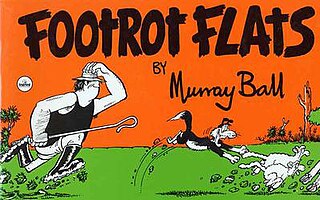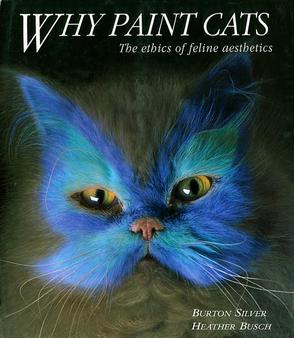Related Research Articles

Speedy Gonzales is an animated cartoon character in the Warner Bros. Looney Tunes and Merrie Melodies series of cartoons. He is portrayed as "The Fastest Mouse in all Mexico" with his major traits being the ability to run extremely fast, being quick-witted and heroic while speaking with an exaggerated Mexican accent. He usually wears a yellow sombrero, white shirt and trousers, and a red kerchief, similar to that of some traditional Mexican attires. To date, there have been 46 theatrical shorts made either starring or featuring the character.

Footrot Flats, a comic strip by New Zealand cartoonist Murray Ball, ran from 1976 to 1994 in newspapers. Altogether there are 27 numbered books, a further 8 books collecting the Sunday newspaper strips, and 5 smaller "pocket" books of original material, plus various related publications. The strips inspired a stage musical, an animated feature film called Footrot Flats: the Dog's Tail Tale, and the Footrot Flats Fun Park in Auckland, New Zealand. The strip reached its peak of popularity in the mid-1980s, with the books selling millions of copies in Australasia.

Louis William Wain was an English artist best known for his drawings of anthropomorphised cats and kittens.
Cartoon physics or animation physics are terms for a jocular system of laws of physics that supersedes the normal laws, used in animation for humorous effect.

Margaret D. H. Keane was an American artist known for her paintings of subjects with big eyes. She mainly painted women, children, or animals in oil or mixed media. The work achieved commercial success through inexpensive reproductions on prints, plates, and cups. It has been critically acclaimed but also criticized as formulaic and cliché. The artwork was originally attributed to Keane's ex-husband, Walter Keane. After their divorce in the 1960s, Margaret soon claimed credit, which was established after a court "paint-off" in Hawaii.

Dylan Horrocks is a New Zealand cartoonist best known for his graphic novel Hicksville and his scripts for the Batgirl comic book series.
Raymond Ching, also known as Raymond Harris-Ching and Ray Ching, is a New Zealand painter. Ching is known for his contemporary bird and wildlife paintings. His ornithological illustrations have appeared in books such as The Reader's Digest Book of British Birds.

Why Paint Cats is a humorous book written by New Zealand author Burton Silver and illustrator Heather Busch. It is one of three cat art books, including Why Cats Paint and Dancing with Cats. The book purports to describe the practice of "cat painting", the decorating of cats with paint. Some readers were concerned at the dangers of applying paint to cats, but the book's depictions are digitally manipulated.

George Worsley Adamson, RE, MCSD was a book illustrator, writer, and cartoonist, who held American and British dual citizenship from 1931.

Simon's Cat is a British animated web and book series written by Simon Tofield. It features a fat, hungry white cat who uses various tactics to get his owner to feed him.
Why Cats Paint is a comedy book written by New Zealand author Burton Silver and illustrator Heather Busch.

An exotic pet is a pet which is relatively rare or unusual to keep, or is generally thought of as a wild species rather than as a domesticated pet. The definition varies by culture, location, and over time—as animals become firmly enough established in the world of animal fancy, they may no longer be considered exotic.
Milton Knight Jr. is an American cartoonist, animator, comic book artist, writer, painter, and storyboard/layout artist. He directed animation for a variety of cartoon series, including Cool World, Adventures of Sonic the Hedgehog, and The Twisted Tales of Felix the Cat. He is known for his Golden Age (1930s) cartooning style.

The European hedgehog was brought to New Zealand by British colonists in the 1870s to remind them of their homeland. They have spread throughout the country, being absent only in inhospitable environments. The general public has a benign attitude to them but conservationists and regional councils regard them as pests, as they prey on native animals and compete with them for food.

ROA is a graffiti and street artist from Ghent, Belgium. He has created works on the streets of cities across Europe, the United States, Australia, Asia, New Zealand and Africa. ROA generally paints wild or urban animals and birds that are native to the area being painted. ROA usually uses a minimal color palette, such as black and white, but also creates works using vibrant colours depicting the flesh or internal systems within the animals and birds.
"ROA treats each surface he paints like a space to investigate, play with, and fit his creatures into. The technical perfection of his painting belies an underlying resourcefulness with simple tools,” “The animals are matched to their location, with rats in New York City and elephants in Bangkok. There are dark and funny messages, the beauty of both life and death, universal metaphors, inside jokes, and occasional violence, but always in ways that honor the animals and the spaces where they are painted."

Jacqueline Mary Fahey is a New Zealand painter and writer.

Harry Hargreaves was an English cartoonist, best remembered for The Bird, which he produced for Punch, and for Hayseeds in the London Evening News.

Sharon Murdoch is a cartoonist born in 1960 in Invercargill, New Zealand. She is the first woman to regularly produce political cartoons for New Zealand mainstream media, and draws the cartoon cat Munro who accompanies the daily crossword in Fairfax newspapers. Murdoch has won New Zealand Cartoonist of the Year three times: 2016, 2017 and 2018.
Bogor is a newspaper cartoon strip that ran from 1973 to 1995. It was created by New Zealand cartoonist and author Burton Silver (1945–present). Its characters include Bogor, a lone "woodsman poet" who lives in the forest by himself, and hedgehogs and snails who often get stoned on marijuana. Bogor regularly talks to the trees, and can also be seen writing books about the environment he lives in or laboring over 'annual examinations'. The hedgehogs' diet consists of snails, and since both species understands each other, make for some interesting dialogue. Bogor's attire predominantly consists of the classic New Zealand black singlet, short pants, or Stubbies, and boots. He is often seen wielding an axe or a chainsaw which he uses to cut down trees. Running jokes include how Bogor hates marijuana and condemns the animals he catches using it, and looking at the stars at night often brings out a philosophical side. There are also strips that focus on the animals and their interaction with each other. Predominantly focused on snails and hedgehogs, the jokes often include the ways in which snails try to hide from the hedgehogs and the ways in which the hedgehogs consume the snails, complete with dialogue between the two species.
References
- ↑ "About Burton Silver". Random House . Retrieved 9 November 2012.
- ↑ "Bogor Comic Strips Gallery". Tony's Trading. Retrieved 9 November 2012.
- ↑ Bigelow, Deborah (15 Sep 2007). "Self-Help". Library Journal. Archived from the original on 12 October 2008. Retrieved 9 November 2012.